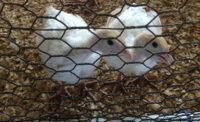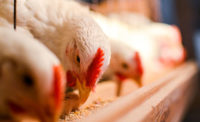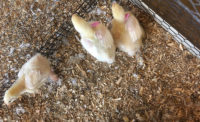Commercially reared poultry have increased in size over the last 50 years through improvements in nutrition and genetic selection. This increase in weight, however, has also put pressure on their extremities, including legs. Carefully implemented genetic selection for larger birds has included increased breast meat proportions to satisfy white-meat demands by consumers. In keeping up with market demands, some unintended consequences that are becoming evident must be addressed for the health of our bird populations and industry alike, especially as it relates to leg health and bird mobility.
Within the realm of science is an omnipresent theme — the maintenance of homeostasis. Body systems work together to form one entity and changes in one system can lead to an imbalance in another. For example, in poultry, skeletal structure may become unable to support the meat deposition of commercial birds as growth occurs faster than seen previously. The entire bird must be healthy and supporting traits are accounted for in genetic selection. Despite this, “genetics” always appears to get a bad rap and has been the go-to answer to explain several varieties of bird health issues. But bird health is a complex and worthy discussion in the poultry industry, as there are many contributing factors in bird health and maintenance. There are many variables that affect leg confirmation, and the answer may not be as straightforward as you may think.
Avian species lay eggs. If these eggs are fertilized, incubated and hatched, there are several points during this process that can lead to leg issues before the bird hatches. During incubation, there are both environmental and internal (bird) factors that must be taken into consideration. Incubation cycles can be divided into three phases: differentiation, growth and maturation. There has been extensive research indicating that any deviations during these key points can have immense effects later in a bird’s production lifetime that are not limited to leg issues. Limb formation in most avian species occurs early in incubation: chickens begin development of the limb buds by day 5 and limb differentiation starts by day 6. Any changes from optimal during the incubation phase, such as temperature fluctuations, can alter limb development, especially since the chicken incubation cycle is only 21 days. The turkey’s incubation cycle is a bit longer, lasting about 28 days, which is why there is not one set incubation process for all commercial poultry.
Some leg deformities can be species- or breed-specific. These issues can arise from behavioral differences, such as how a broiler chicken versus a turkey tom may act in a given production cycle. For example, a broiler chicken typically will walk a few steps, lie next to the feeder and stay, completely content to eat most of the day. A turkey tom, on the other hand, will eat then spend an extended amount of time performing tail fanning displays or defending his title with the flock social hierarchy. These behavioral differences, not to mention the variation in the size of these animals, can all effect how the legs form beneath the weight of a growing bird.
Bacterial and other types of inflammatory infections can cause locomotion problems. One of the leading infections that deteriorates bone integrity in broiler chickens is bacterial chondronecrosis with osteomyelitis. This disease affects the leg bones of the bird and causes femoral head necrosis which leads to locomotion issues that negatively affect welfare, feed efficiency and overall performance. This microorganism appears to be opportunistic, and infection is believed to happen early in production when the bones are being mineralized and converted from cartilage into bone. The bacteria invade the growth plates of the bird and infection starts from the inside, ultimately resulting in colonization by Staphylococcus, E. coli and Enterococcus, which have all been isolated from samples taken from birds infected with bacterial chondronecrosis. At this time, there are studies being conducted to prevent these bacteria from colonizing in the joints of birds and reducing the associated loss of mobility.
Rapid bird growth can be a contributing factor, which may be because of some genetic selection of bird type used for production. Slipped leg tendons can be an issue and have nothing to do with a bacterial or inflammatory response to a microorganism. The mechanism behind this problem is that the bird grows rapidly and energy expenditure is used for meat production instead of other functions, such as building strong tendons or converting cartilage to bone quickly enough to meet the demand of the increase in body weight. Interestingly, these problems can manifest at any time during production. Birds can have slipped tendons within the first few days post-hatch or may not show symptoms until a week before harvest.
In addition, studies have shown that environment has an impact on leg formation. One example of an external problem is footpad dermatitis which can be caused by wet floor litter. Another is stocking density of birds in a specific area, which can contribute to an increase in ammonia that can also cause burns on the bottoms of the paw, causing an increased chance of footpad dermatitis. In addition to increased ammonia with stocking density, there are also other implications, such as area to move within the flock and social interactions with conspecifics in closer corners. Birds without the ability to display proper avoidance behaviors by leg deformities can also arise in these situations.
I do not believe there is one reason for leg deformities or locomotion issues in poultry production. I believe there is a highly integrated mechanism behind leg mobility issues that cause a decrease in welfare of birds. These problems can begin well before hatching occurs or can surface the week before birds are destined for harvest. It is important to use our best judgment for when these problems do arise and consider the welfare of the birds. This can be a very difficult decision to make, especially toward the end when a production animal is almost ready to be shipped to the harvesting facility. Euthanasia is never an easy option, but must be considered if locomotion is no longer possible. Leg deformities and mobility issues are a fundamental concern for the poultry production industry and need to be discussed on a larger scale. NP






Report Abusive Comment